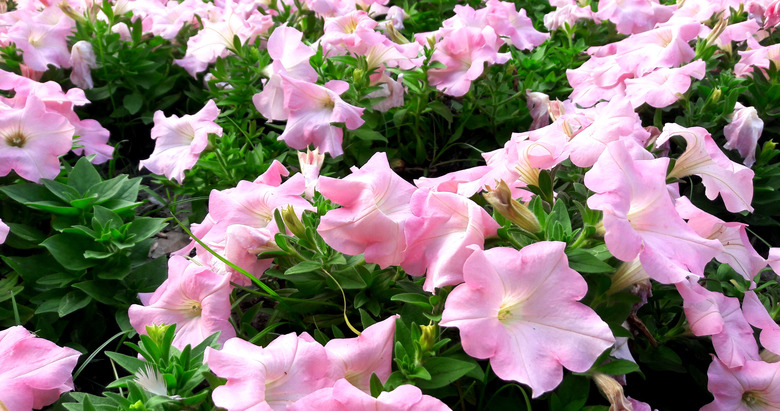What Is Eating The Flowers On My Petunia Plants?
We may receive a commission on purchases made from links.
Is something eating the flowers on your petunia plants? Petunias (Petunia x hybrida, USDA zones 10-11) fill the showiest of flower beds or the humblest of hanging baskets with spring-to-fall color. These tough, sun-loving annuals grow in bush or trailing forms, with trumpet-like, single or double blooms, and these beautiful annuals add delightful fragrance to your garden. One of their few liabilities is that a tiny, flower-devouring striped worm finds petunias irresistible.
Tip
Tobacco budworms often eat petunia buds. Rabbits and deer can also be the cause of petunias being eaten.
Identification of Tobacco Budworms
Identification of Tobacco Budworms
Gardeners across the United States risk finding their prize petunias infested with tobacco budworms. These green caterpillars are the larvae of the 1 1/2-inch wide Helicoverpa virescens moth.
The female moths deposit their eggs on a petunia's foliage and buds at dusk. The eggs hatch into striped caterpillars. Their colors range from light green or light brown to red and other dark shades. The coloration acts as camouflage and varies according to the plants on which the pests feed.
Life Cycle of Tobacco Budworms
Life Cycle of Tobacco Budworms
Newly hatched tobacco budworms feed on a petunia's flowers for about four weeks before falling to the ground. They tunnel from 2 to 6 inches deep, build dirt cocoons and pupate. Where winter temperatures remain above 20 degrees Fahrenheit, the caterpillars entering the soil in autumn can survive until spring. The adults emerge after pupation to mate and lay eggs. Two generations of these worms typically attack petunias in a single growing season.
Damage to Petunia Plants
Damage to Petunia Plants
The tobacco budworms feed on flower buds and flower ovaries. Some buds don't open at all. Infected buds that do open have chewed, shredded petals. Budworm infestations, and the damage they cause, worsen as the summer passes.
Tobacco Budworm Control
Tobacco Budworm Control
Checking your petunias daily for chewed buds and blooms is the best way to limit tobacco budworm damage. The caterpillars feed most heavily in the early evening. Examine the plants, then manually remove and destroy the worms. If that's impractical, do a daytime check under the petunias' lower leaves and around their bases as the worms frequently hide in the soil during daylight. Tilling your petunia bed in fall destroys overwintering pupae.
Parasitic wasps feed on tobacco budworm caterpillars. The campoletis wasp (Campoletis sonorensis) attacks the young larvae, while Cardiochiles nigriceps goes after mature caterpillars ready to pupate. Several species of paper wasps also kill the pests.
Tobacco budworms are somewhat insecticide-resistant. Spinosad-based insecticides as well as those containing synthetic pyrethrins are most likely to succeed in controlling them. Look for insecticides containing bifenthrin, permethrin or esfenvalerate.
Rabbits and Deer
Rabbits and Deer
Budworms aren't the only ones potentially munching on your petunias. Larger animals, especially rabbits and deer, are known for making a meal of many different flowers, including petunias. Rabbits often leave behind pea-sized droppings or tufts of fur, and you might see signs of digging. When a rabbit eats your petunias, it makes a clean cut due to its upper and lower incisors.
Deer sometimes leave behind hoof prints in your garden. Bean-shaped droppings can also be a sign of deer in the garden. You'll often notice a more jagged appearance on the petunia plants that deer eat.
Controlling Rabbits and Deer
Controlling Rabbits and Deer
Deer and rabbits are both difficult to keep out of your garden, but barriers, repellents and scare tactics can help. Chicken wire around garden areas can keep rabbits out. The fence needs to be a minimum of 2 feet tall, and it needs to be buried 6 inches or more to keep them from burrowing under it. Netting over fenced-in areas can help keep rabbits and deer away from your flowers.
Chemical repellents can discourage critters from approaching your garden. You can get ready-to-use deer and rabbit repellent to take care of both problems with one product. Some repellents need to be applied again after rain, and many aren't suitable for edible plants. Read the label for specific instructions and warnings.
Things placed in the garden to scare away rabbits and deer can also help. Metal pie pans hanging in the garden often make noises that scare away animals. Motion detectors that make noises or flash lights can also work.
